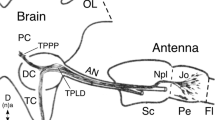Abstract
THE mechanisms by which airborne molecules stimulate the olfactory receptors of insects remain largely undefined. In the Insecta, antennal sensilla contain pores which connect the external environment with the receptor membrane of the dendritic nerve endings1–3. The ultimate fate of the stimulant molecule that enters the pore is not yet known. Unpublished data cited by Schneider1 and Kaissling4 indicated that bombykol (E)-10, (Z)-12-hexadecadien-1-ol, was progressively metabolized into acid and ester after absorption on the antennae, or other body parts of males and females of Bombyx mori (L.). This finding cannot be directly correlated with any specific step in the olfactory mechanism, but it suggested that an enzymatic process might be involved at some point. Other indications of chemical stimulants interacting with protein substances in the antennae of insects have been reported5,6.
Similar content being viewed by others
References
Schneider, D., in The NeuroSciences: Second Study Program (edit. by Schmitt, F. O.), 511 (Rockefeller University Press, New York, 1970).
Borg, T. K., and Norris, D. M., Z. Zellforsch., 113, 13 (1971).
Steinbrecht, R. A., and Muller, B., Z. Zellforsch., 117, 570 (1971).
Kaissling, K. E., in Handbook of Sensory Physiology Chemical Senses 1 Olfaction (edit. by Beidler, L. M.), 351 (Springer-Verlag, New York, 1971).
Riddiford, L. M., J. Insect Physiol., 16, 653 (1970).
Norris, D. M., Ferkovich, S. M., Baker, J. E., Rozental, J. M., and Borg, T. K., Science, 170, 754 (1970).
Shorey, H. H., in Control of Insect Behavior by Natural Products (edit. by Wood, D. L., Silverstein, R. M., and Nakajima, M.), 249 (Academic Press, New York, 1970).
Toba, H. H., Kishaba, A. N., and Wolf, W. W., J. Econ. Entomol., 61, 812 (1970).
Lowry, H., Rosenbrough, N. J., Farr, A. L., and Randall, R. J., J. Biol. Chem., 193, 265 (1951).
Ash, K. O., Science, 162, 452 (1968).
Dastoli, F. R., and Price, S., Science, 154, 905 (1966).
Tumlinson, J. H., Mitchell, E. R., Browner, S. M., Mayer, M. S., Green, N., Hines, R., and Lindquist, D. A., Environmental Entomol., 1, 354 (1972).
Laskowski, M., in Spectroscopic Approaches to Bimolecular Conformation (edit. by Urry, D. W.) 7 (Amer. Med. Assoc., Chicago, 1970).
Author information
Authors and Affiliations
Rights and permissions
About this article
Cite this article
FERKOVICH, S., MAYER, M. & RUTTER, R. Conversion of the Sex Pheromone of the Cabbage Looper. Nature 242, 53–55 (1973). https://doi.org/10.1038/242053a0
Received:
Revised:
Issue Date:
DOI: https://doi.org/10.1038/242053a0
- Springer Nature Limited
This article is cited by
-
Spin 3/2 Field Equation: Separation and Solution in a Class of Lemaître–Tolman–Bondi Cosmologies
International Journal of Theoretical Physics (2012)
-
Sex pheromone catabolism in the redbanded leafroller moth
Journal of Chemical Ecology (1993)
-
European corn borer: Pheromonal catabolism and behavioral response to sex pheromone
Journal of Chemical Ecology (1991)
-
Metabolic transformation of tritium-labeled pheromone by tissues ofHeliothis virescens moths
Journal of Chemical Ecology (1986)
-
Increased pheromone catabolism by antennal esterases after adult eclosion of the cabbage looper moth
Experientia (1981)





